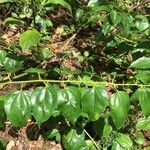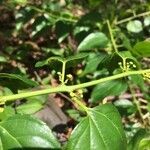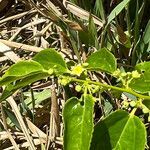Scandent shrub or liane, to 10 m high. Leaves alternate or subopposite; stipules 0.6–1.3 mm long, scarious, broadly triangular to broadly ovate; petiole (8–) 12–18 (–22) mm long; lamina broadly ovate, (35–) 50–65 (–95) mm long, (25–) 30–45 (–70) mm wide, apex bluntly acuminate, crenate, base cordate. Inflorescences comprising shortly pedunculate axillary clusters of rhipidia; axes and flowers sparsely pubescent. Pedicels 1.5–4.5 mm long. Hypanthium saucer-shaped, 2.1–3 mm diameter. Sepals 1.2–1.5 mm long, glabrous or sparsely pubescent. Petals 1–1.4 mm long. Stamens 0.8–1.4 mm long; style 0.4–1.2 mm long, branched. Fruits brown, 6–9 mm long; torus in the lower third or basal. Seed 4–5.5 mm long, brown.
A tall shrub 3-7 m high. It tends to climb. The branches are slender and flexible. They are often trailing. The leaves are alternate. The leaves are 5-8 cm long, by 2-3 cm wide. They are oval, and heart shaped at the base and taper to the tip. There are teeth along the edge of the leaf. The leaves are dark green and shiny, with 3 prominent veins. The flowers are in the axils of leaves, and dense. The flowers are 0.4 cm across and greenish. The fruit is 0.8 cm across, and furrowed and somewhat sunken at the top.






